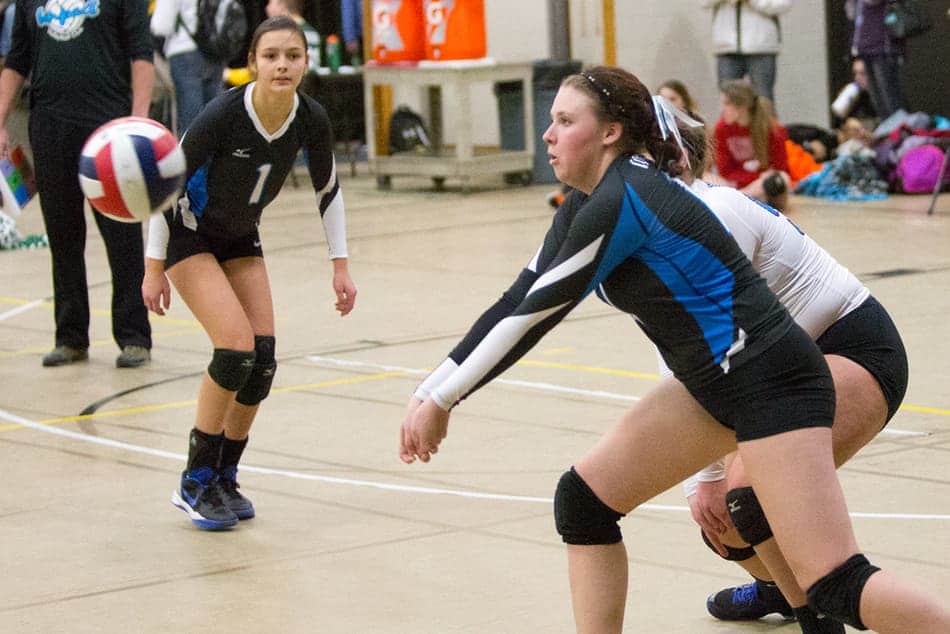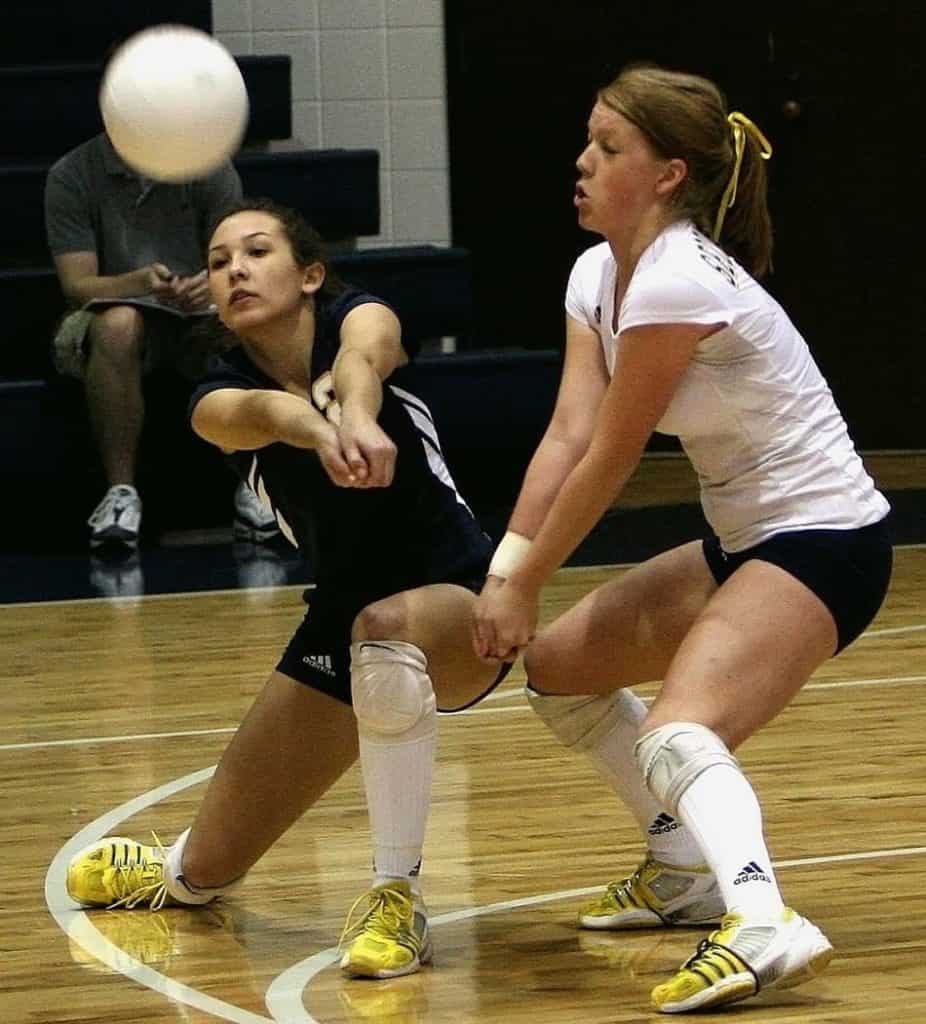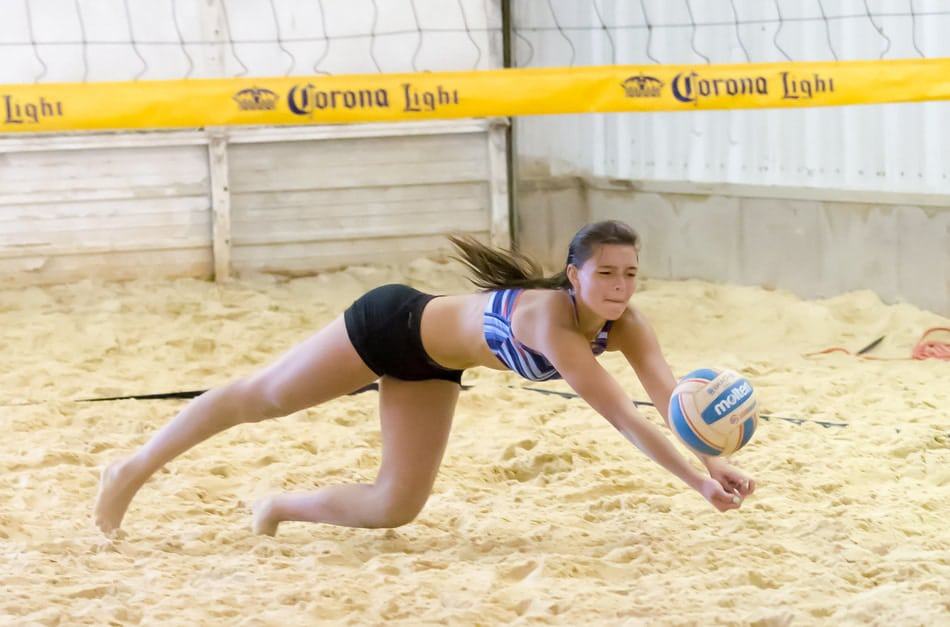During volleyball games, you will see a wide variety of calls. Sometimes a referee will call the same call multiple times in a short time frame. Double hit calls have a tendency to run in a streak like that.
What is a double hit in volleyball? A double hit is when one player makes contact with the ball twice in a row. Whether intentional or unintentional, the second hit is an illegal hit.
What Does a Double Hit Look Like?
In beginner levels of volleyball, players may simply choose to hit the ball a second time because they either forget the rule or they feel that none of their teammates will be able to make the next hit. These are simple to identify for the average person.

At higher levels of competition, it will often be difficult to detect a double hit because they may happen so quickly. The referee has to make a judgment call based on their view and the reaction that the ball has from the contact(s).
Many doubles are called at first contact off of the service and those are discussed further down in the article. Double hits are usually accidental as the player attempts to make a normal pass, but inadvertently makes contact with the ball with another part of their body.
For instance, as they are bending low to pass the ball their knee comes between their arms and makes contact with the ball. Another common accident is while setting, the player misjudges the ball’s speed or trajectory and it contacts their shoulder, head, or face before they complete the set.
Sometimes double hits are really no fault of the player. When digging a hard-driven spike, players may attempt to perform a clean pass, but the ball may ricochet off their shoulder, upper arm, or head. The only way to stop this from ever occurring is to be in the right position every time, quite the challenge for our defensive specialists and liberos.
The rules actually allow for the ball to contact multiple body parts as long as it’s from one action or one motion, but that requires interpretation from the referee. So if the ref doesn’t call it, play on!
Exceptions To the Double Hit Rule
The main exception to making a double hit in volleyball is when blocking. The block does not count as a hit. So when a player performs a block, whether the ball is sent up into the air, or drops, that same player can legally make contact with the ball again right away.
Just to be clear, the double hit rule does not limit a player from hitting the ball twice while it is on their side of the net. Every time the ball reaches your side of the net your team has 3 hits to play it over.
The first person to touch the ball can hit it twice as long as their hit is separated by another player hitting the ball in between. Again, the block does not count as a hit, so technically it’s possible for one player (the blocker) to make 3 legal contacts with the ball during it’s 1 trip to your side of the court, though this is very rare.
What About When Two Players Hit Simultaneously?
It is completely fine for 2 players to hit the ball at the exact same time. When players both call the ball and follow through because they want to make sure the ball gets played, two aggressive players may both make contact. No rule has been broken.

The main challenge becomes that neither of them is allowed to make the next hit. Their 2 hits now take up 2 of the 3 hits their team is allowed, so another player must make the final contact to play the ball over the net.
Often these situations happen so quickly it is difficult for the eye to perceive exactly who hit the ball and who didn’t. Coaches should encourage players to make this as obvious as possible for their teammates and the referee by doing one of three things:
- Any player who made the contact, peel off. If you know you touched the ball get away from the action.
- If you didn’t touch the ball but another teammate is close enough to make the next hit, play it safe. Call for help and let that teammate handle it.
- If you didn’t touch the ball, and no one else is going to be able to make the next hit, call that next hit. Immediately yell, “MINE, MINE, MINE.” If you have the presence of mine and enough time while the ball is in the air, there’s no reason you can’t yell, “MINE, I DIDN’T TOUCH IT!” The ref may still call a double on you, but at least you’re doing everything you can to make your situation clear.
Double Hits Off the Serve
Many double hits are called on the first contact of a hard serve. This really comes from a misunderstanding on the part of the receiver and sometimes form inexperienced referees.
Players are coached so strongly from a young age to only use their platform to receive serves and that they should not be trying to set the serve. They have that drilled into their head and then when they are put in the position to have to overhead pass they are unprepared.
An overhead pass looks similar to a set, but it’s not the same. When you are trying to play a hard driven ball, it’s completely legal to use an overhead pass. If you try to set it, that’s where things go wrong.
If you approach the ball the same that you would a pass from your teammate or a freeball, you will make double contact, the ball will react poorly and the referee will probably call you for a double hit every time.
How to Overhead Pass to Avoid Double Hits
So when you decide you need to overhead pass instead of using your platform, approach the ball in a lower ready position and lean forward. You have to have firm hands and try to square yourself with your target so that you’re making one smooth straightforward motion.
You want your hands, wrists, and arms to be firm and push through the pass. As long as you’re making an overhead pass it can be much more sloppy and rough. The rules allow for this and referees should use much more leniency to your hit.
Why Do Setters Get Called For Double Hits?
When a setter makes their pass they want to make it as clean as possible. But like so many things in sports, that’s easier said than done. Sometimes they are running for their lives, avoiding a collision, or jumping into the air while making this pass. Keeping your pass crisp and clean can be a challenge!
Many double-hit calls come when a referee perceives that the setter has made contact with the ball in an uneven or consecutive way instead of with both hands simultaneously.
Referees are taught to watch the spin of the ball as it leaves the setter’s hands. If it is spinning sideways, some refs will call it every time. If it is spinning sideways quickly, most refs are going to call it.
Referees are usually a little more relaxed at the younger levels of play because they have lower expectations for perfect hits. It’s also common for referees at some levels to hold setters to a very high standard, but if other players on the court were to do the exact same pass, they let it go without a call.
Remember that referees are human too. I know, it may be hard to feel that way when you keep getting that whistle blown on you and they’re holding up the peace sign (2 hits again!). But it’s human tendency to expect a higher level of clean passing from the setter than from someone else who is just making their best effort. Right or wrong, you’re not going to change the ref’s mind, so just expect it and play through it.
Related Questions
What is a Hard-Driven Ball in Volleyball?
A hard-driven ball is an aggressive hit that is coming with serious speed and downward trajectory. These are hard overhand serves and spikes. Whenever you are sending the ball over the net, you want it to be hard-driven to make it as difficult as possible for the other team to handle.

What is a “Double Double” in Volleyball?
In volleyball, there are 5 main statistical categories that everyone tracks: Aces, Kills, Blocks, Digs, and Assists. A double double is when a player achieves double-digit totals in 2 of these 5 categories in their match. Similarly, a triple-double would be double-digit totals in 3 of the 5 categories.
Learn more about volleyball terms by checking our post called: Volleyball Terms, Stats, Acronyms & Abbreviations
Photo credits:
Black and blue passing image by popo.uw23, available in public domain: https://creativecommons.org/publicdomain/mark/1.0/
Double pass image by Keith Johnston from Pixabay
Sand dig image by popo.uw23, available in public domain: https://creativecommons.org/publicdomain/zero/1.0/
Recent Posts
Athletes, listen up! Do you have a closet full of old jerseys, sweatpants, and tees that you just can't seem to part with? Well, dust them off, because you're sitting on a goldmine of fashion...
You may have heard, or you may have noticed, that there's been a change to the rule about double contact in volleyball. In 2022, an experimental rule change began to be implemented, where the double...
